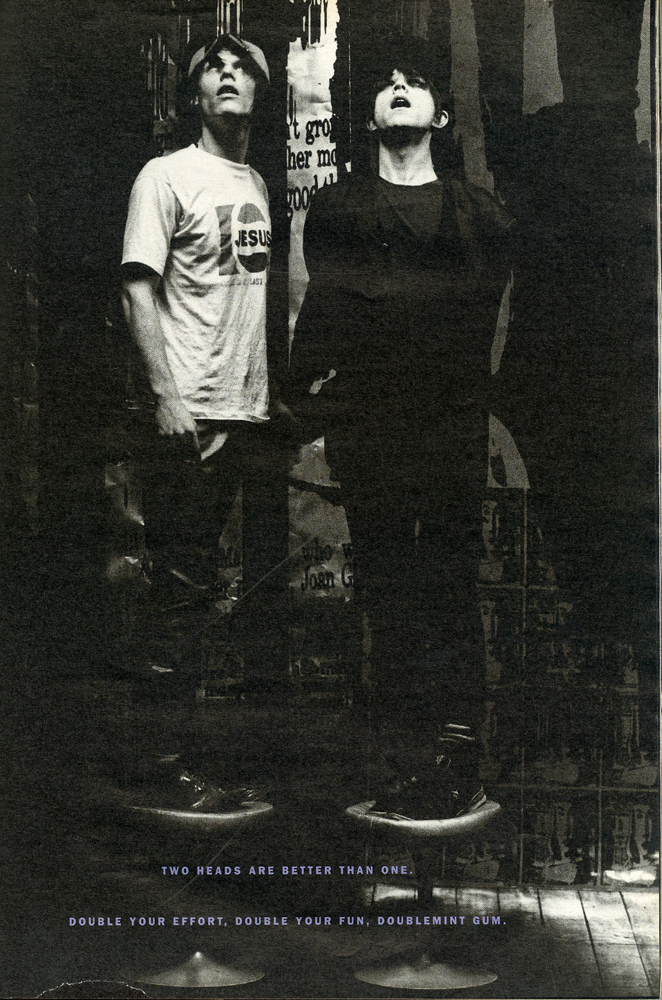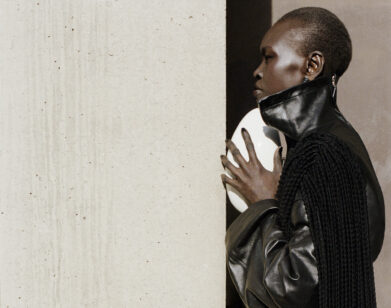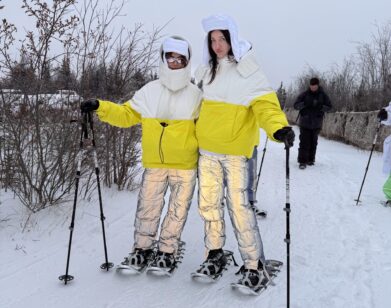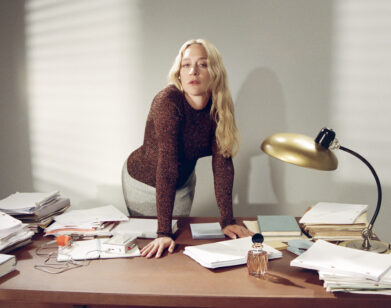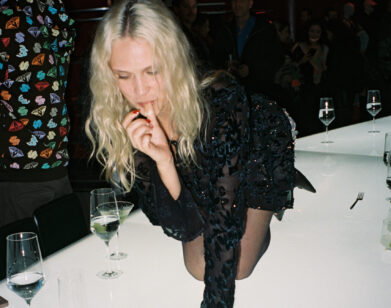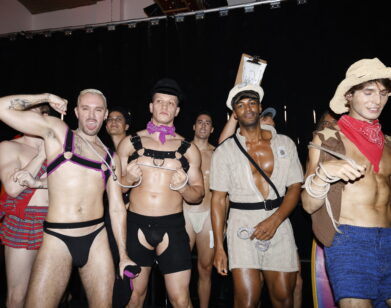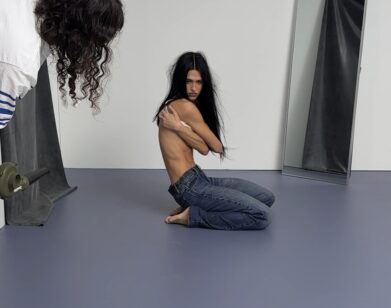25 Years of Stephen Sprouse
Steven Meisel photographs, Stephen Sprouse, Stephen Ashby, June 1990
Stephen Sprouse was a reliable friend of Interview, acting as both interviewer and interviewee. Man and magazine met in June 1984: Then, introducing himself and his upbringing to Berry Berenson, Sprouse articulated ambivalence being labeled merely a fashion designer. His interest in making both art and music recur in a September 1987 interview. His December 1990 interview followed on a June show of his paintings in collaboration with Stephen Lee Ashby-they also shared the interview, conducted by Debbie Harry. It’s fitting that tonight begins a perfect storm of Sprouse activity that sees the launch of a Marc Jacobs Louis Vuitton line in honor of the designers’ collaborations, and that it happens at Deitch Projects, in conjunction with a retrospective of visual art, titled “Rock on Mars. “
Below, we’ve included excerpts from the three aforementioned interviews:
Stephen Sprouse and Berry Berenson, photographed by Bradford Branson; photograph by Berry Berenson
JUNE 1984
Berry Berenson was the granddaughter of Elsa Schiaperelli and an accomp[lished fashion photographer and actress in her own right. She wasmarried to Anthony Perkins for nearly 20 years until his death from AID in 1992. She died, sadly, in the 9/11 attacks.
SS: I grew up in Columbus, Indiana, a kind of industrial and farmland place. It’s south of Indianapolis; a town of about 30,000 people. I lived in town until I was eight and then I moved nearer the farmland, so I had a mixture.
Berry Berenson: What kind of hobbies did you have when you were a child?
SS: I watched television a little, but mostly just drew and read magazines.
BB: Fashion magazines?
SS: Yes, like Vogue.
BB: How old were you when you began reading about fashion?
SS: Eight.
BB: So rather than sit and watch television, you would pick up a pad and pencil and draw. Would you draw from the pages of Vogue?
SS: Yes. That’s how I taught myself how to draw-tracing the ads and putting new clothes on the models.
BB: Did you friends think you were a little strange?
SS: I told a couple of friends, but not very many.
BB: You have a brother, too. Was he interested in fashion?
SS: No, he was always playing sports with his friends.
BB: Did your parents encourage you?
SS: Yes, so in a sense I was lucky, because in that part of the country they really could have been pushing me to go play on the team, and they didn’t.
BB: Did you finish high school?
SS: I finished high school thee and then I went to Rhode Island School of Design. When I went to college, I wasn’t interested in fashion anymore—I was interested in art.
BB: So you actually then wanted to be a painter or an artist?
SS: Right, because it was kind of the hippie period around 1971, when I went to college. But late in high school I had been a hippie, and fashion didn’t seem as important.
BB: Had you always wanted to go to New York?
SS: Yes. I used to go there in the summers when I was a teenager.
BB: When you came to New York, where did you work?
SS: I went to work with Leo Narducci, a designer who I’d worked with when I was 16 one summer in New York. And I got permission to leave school since I got a job with him in the city, which was fine with me because I wanted to be away from Rhode Island.
BB: So you left completely after that?
SS: Not until I got the job with Halston. Leo called up a designer named George Halley and said my stuff looked like Halston and had I ever met him, and I said no, but that I had admired him and thought Halston’s stuff was great at that point. So went up there and Halston hired me. He asked me about college and I said I didn’t like it and he said, “Oh, well, I need an assistant. Why don’t you just come to work here?” So I quit school and went to New York.
SEPTEMBER 1987
Edit DeAk is an art critic who published Art-Rite in the 70s.
Edit DeAk: When did you start making clothes for Debbie Harry?
SS: In 1975, I moved into the building that she and Chris Stein lived in. They lived on the bottom floor. I lived on the top floor with a hot plate. The guy who owned the building lived in the middle. We all became friends. As for the clothes, we’d cut up old stuff and pin it together. Then they’d go up the street and play at CBGB’s. Punk kind of started in New York and then went to England. I think Malcolm McLaren was here at the time, handing around with the [New York] Dolls, and England made punk really big.
ED: Aren’t you just repeating punk?
SS: Right now it’s kind of repeating a ten-year period. I think the reason cycles are being repeated is that in this People magazine generation, information gets absorbed so fast that you’ve got to repeat the past quicker. You can basically repeat what was in style a couple of years ago, and it’s new gain because so much was absorbed in the meantime.
ED: There’s no new image anyway, right?
SS: No. There’s nothing new happening in New York and there hasn’t been for some time. It’s kind of weird. Maybe next year; 1988 should be a good year. Plus it’s only twelve years until the year 2000.
ED: Do you think you’re working toward space, the space age?
SS: I hope so. New York is so boring that you’ve got to leave it as much as possible, go wherever you can and see whatever you can, and bring that information back and recycle it, put it out as something new. That’s why space shuttles would be great—you could go out to space and get ideas and get new ideas and information and bring them back.
ED: What about space creatures?
SS: I think because of sex we would want them to be kind of like us at least physically.
ED: You’d like to have sex with an outer-space person.
SS: Yeah. Wouldn’t you?
June 1990
Deborah Harry met Stephen Sprouse when they lived in the same apartment on the Bowery. She’s the lead singer of Blondie, and a successful solo artist and actress.
Deborah Harry: Before 1973, you were making art with a Xerox machine.
SS: I was making color-Xerox stuff. I remember the first color-Xerox machine in New York was on Sixth Avenue and Twelfth Street, and I would go and spend hours there. Then I started getting into big stuff. It’s all about blowups. I blew you up in the 70s. That’s when I got the idea to make things big. And that’s when I got into Day-Glo. The first big work I ever made was when I took Kate Simon’s Polaroid of you with Edie Sedgwick-looking eyes and blew it up big enough to be a backdrop for your first video. I found a giant Photostat house; it’s actually the same place we’re using now to make paintings. We’re still using giant Photo stats, but now they’re on plastic.
DH: Did you ever show the Patty Hearst paintings and the original scan-line paintings? What did you call those paintings?
SS: Plastic paintings. No. I wanted to have a show. I knew Jane Holzer, and she was always really interested in my work, so once she sent me to Leo Castelli and Ivan Karp. I actually met them. I went down there with slides, but I was so crazy I thought they’d give me a show right away. They said they needed to see the real work. I didn’t know how to get the real work to the gallery. I didn’t even know about studio visits. So I never called them back. I didn’t understand the art process.
DH: Did you know Andy then?
SS: Not really. Andy started talking to me at a party. He had always been my hero, so I didn’t’ know what to say to him. So I told him about a dream I had had two nights before about Robert Mapplethorpe. I used to see Robert Mapplethorpe at parties. He always looked very cool. He looked like the original Patti Smith. He looked like a poet. I was describing my dream to Andy because I knew Andy would know who he was, and I must have described him right, because Andy said, “Oh, that’s Robert Mapplethorpe.” And I said, “Oh, how old is he?” Then Andy said, “Well, did you come?” I got so nervous I got up and left the party.
DH: Did you believe that coincidence he had a lot to do with your life and work? You know, ESP?
SS: I think that happens a lot. You and I met over a hot plate on the Bowery when we were living in the same building. Stephen Ashby didn’t know I was making paintings with crosses, and he gave me a cross.
DH: I don’t know if that’s ESP, but I think ideas are in the wind and connections are meant to happen.
SS: I’ve found the longer I live, that when you have it in your head that you want something to happen, it happens. It seems that you meet who you’re supposed to meet when the time is right, not before.
Photographed and styled by David Yarritu and Mriuccia Cassadio, December 1992.
The authors of The Stephen Sprouse Book interviewed Sprouse muse Teri Toye exclusively for Interview. Read it here.

